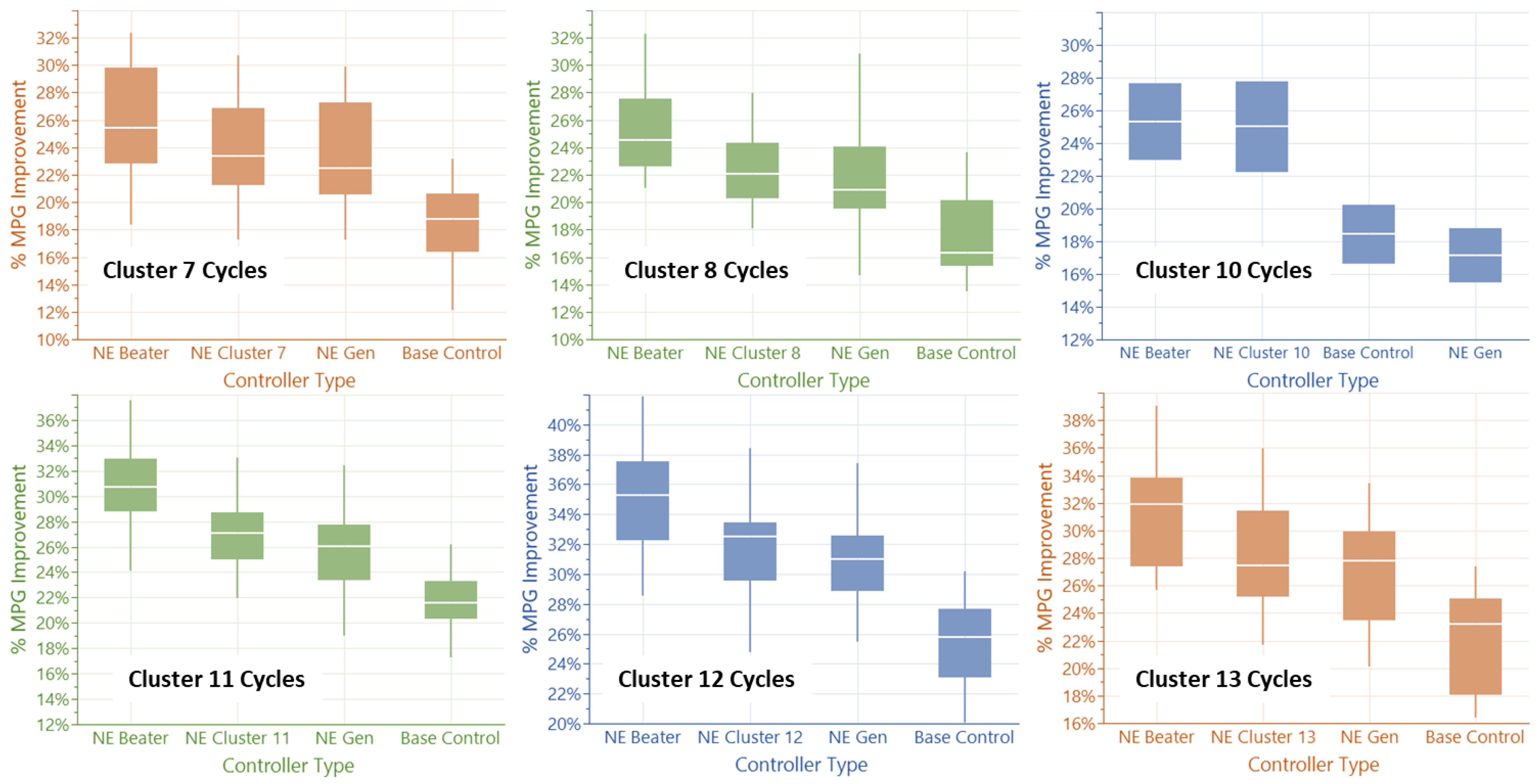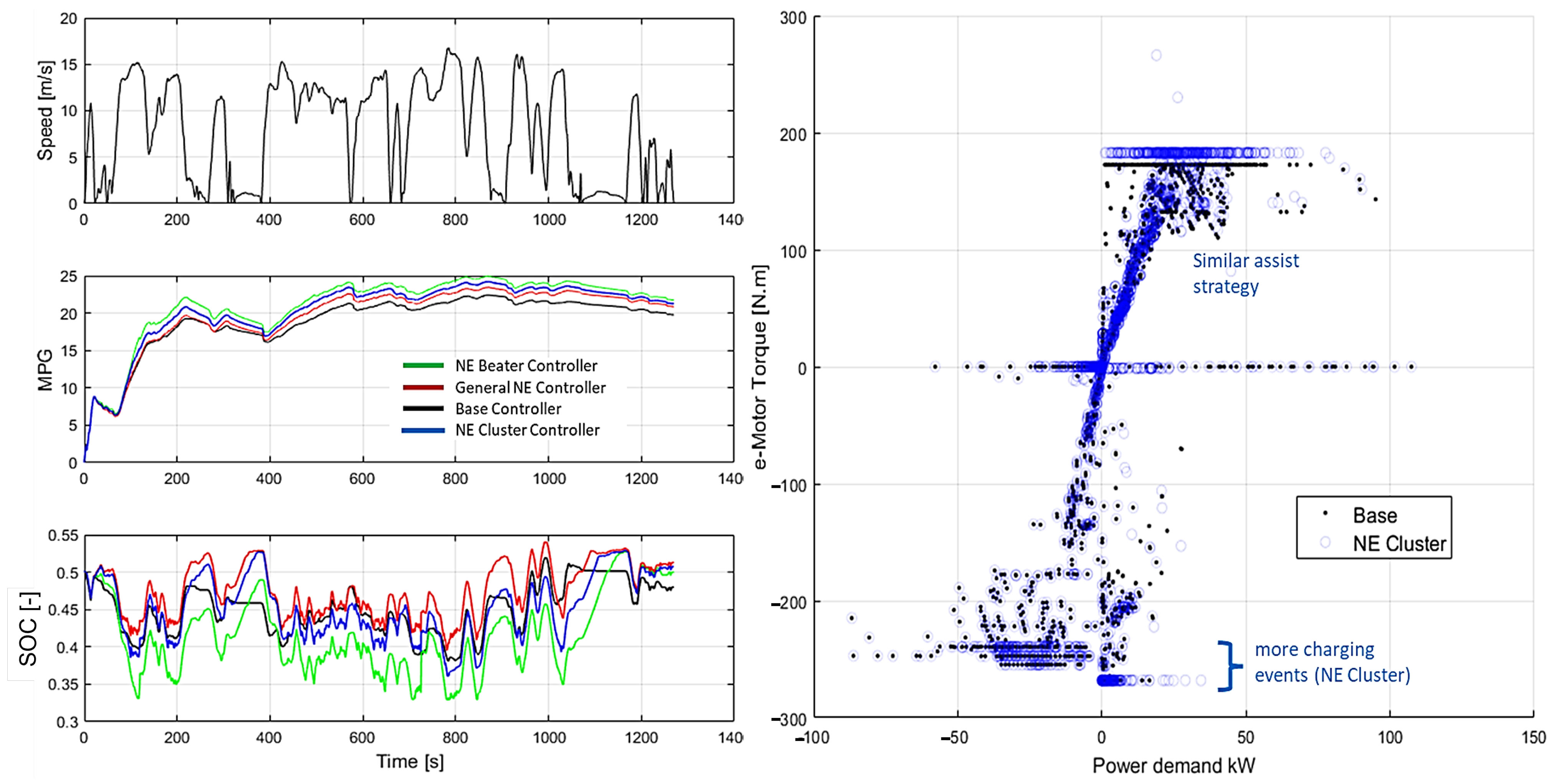Real Time Predictive and Adaptive Hybrid Powertrain Control Development via Neuroevolution
Abstract
:1. Introduction
2. Materials
- First, the NE controller input layer receives an instantaneous stream of stimuli in the form of vehicle and powertrain sensor signals.
- Second, NE internal parameters (weights, bias, and activation functions) are adaptively uploaded to the NE controller based on the current route classification results. We assume here that the route is known, for example, via a GPS based eco-routing function.
- Third, a local e-Horizon re-classification feature fine-tunes the NE controller behavior. This provides local intelligence to temporarily modify the torque split strategy if needed.
- The road force F is computed for each time step based on the target velocity v. This enables the exact same road load computation for every simulation iteration as it removes driver model noise.where is the density of air, a is the acceleration, is the aerodynamic coefficient multiplied by the vehicle frontal area, m and are the mass and equivalent mass, is the rolling resistance coefficient, and is the road grade angle.where and are the drivelines and engine inertia, is the final drive ratio, r is the wheel rolling radius, and is the current transmission gear ratio at time t.
- The demand Torque at the transmission output (and e-motor) is computed as:where and are the final drive ratio and efficiency, respectively.
- must be matched by a combination of the engine torque and e-motor torque :where and are the transmission ratio and efficiency, respectively. The goal is to find the optimal torque split ratio at each time step to reduce fuel consumption.
3. Methods
- The mode switch neural network is used to decide between HEV modes, i.e. between operating with the Internal Combustion (IC) engine only, assisting the IC engine (including full electric mode), or charging the battery (engine charging mode). Brake regeneration is driven by the original controller braking energy strategy, which is kept unchanged. This neural network uses a competitive transfer function to select the HEV mode based on three output node values (IC only, Assist, Charge).
- Two neural networks, one for the engine assist mode, and one for the engine charging mode, output the level of Torque split to apply relative to the driver demand and powertrain states. These are selectively activated based on the main neural network mode output. The assist neural network outputs a positive torque value in N.m, with a maximum value of 270 N.m. The charging neural network outputs a negative torque value with a maximum of −270 N.m. This provides the mechanism to charge the battery by increasing the demand on the engine. They are both deactivated when in IC-only mode, with a corresponding torque split of zero.
- 108 Swarm particles are initialized with random weight, bias, and activation function encoding values. If transfer learning is applied, one or more particles are initially set with the donor NE controller parameter array.
- NE controllers are uploaded to the drive cycle simulation with their corresponding tuning parameters.
- For each NE controller, two-hundred cycles are simulated, and the average HEV fuel economy benefit and standard deviation is computed and fed back in the optimization loop.
- The PSO algorithm modifies the tuning parameters based on the position of the local and global optimum in the search space. This causes a swarming effect while still exploring most of the search space and hence avoiding staying at local optima. This provides a good balance between global and local exploration to keep convergence time within the set limits.
4. Results
- The achieved cycle beater MPG percent benefit.
- The mean speed and mean moving speed (non-zero speed).
- Maximum speed.
- The mean acceleration and deceleration rates.
- The number of stops per mile.
- The speed, acceleration, and deceleration standard deviations.
5. Discussion
6. Conclusions
Author Contributions
Funding
Institutional Review Board Statement
Informed Consent Statement
Data Availability Statement
Acknowledgments
Conflicts of Interest
Appendix A


References
- Sharer, P.; Leydier, R.; Rousseau, A. Impact of drive cycle aggressiveness and speed on HEVs fuel consumption sensitivity. SAE Technical Paper 2007-01-0281 2007. Available online: https://www.sae.org/publications/technical-papers/content/2007-01-0281/ (accessed on 20 September 2022).
- Panday, A.; Om Bansal, H. A Review of Optimal Energy Management Strategies for Hybrid Electric Vehicle. Hindawi Publ. Corp. Int. J. Veh. Technol. 2014, 2014. [Google Scholar] [CrossRef]
- Johannesson, L.; Asbogard, M.; Egardt, B. Assessing the potential of predictive control for hybrid vehicle powertrains using stochastic dynamic programming. IEEE Trans. Intell. Transp. Syst. 2007, 8, 71–86. [Google Scholar] [CrossRef]
- Patil, R.; Filipi, Z.; Fathy, H. Comparison of supervisory control strategies for series plug-in hybrid electric vehicle powertrains through dynamic programming. IEEE Trans. Control. Syst. Technol. 2013, 22, 502–509. [Google Scholar] [CrossRef]
- Huo, D.; Meckl, P. Power Management of a Plug-in Hybrid Electric Vehicle Using Neural Networks with Comparison to Other Approaches. Energies 2022, 15, 5735. [Google Scholar] [CrossRef]
- Wang, Y.; Jiao, X. Dual Heuristic Dynamic Programming Based Energy Management Control for Hybrid Electric Vehicles. Energies 2022, 15, 3235. [Google Scholar] [CrossRef]
- Wang, H.; Oncken, J.; Chen, B. Receding horizon control for mode selection and powertrain control of a multi-mode hybrid electric vehicle. In Proceedings of the IEEE 90th Vehicular Technology Conference (VTC2019-Fall), Honolulu, HI, USA, 22–25 September 2019; pp. 1–5. [Google Scholar] [CrossRef]
- Wang, H. Development of Dynamic Programming and Receding Horizon Control Strategies for GM Volt II Multi-Mode Hybrid Electric Vehicle; Michigan Technological University: Houghton, MI, USA, 2018. [Google Scholar] [CrossRef]
- Oncken, J.; Chen, B. Real-Time Model Predictive Powertrain Control for a Connected Plug-In Hybrid Electric Vehicle. IEEE Trans. Veh. Technol. 2020, 69, 8420–8432. [Google Scholar] [CrossRef]
- Borhan, H.; Vahidi, A.; Phillips, A.; Kuang, M.; Kolmanovsky, I.; Di Cairano, S. MPC-based energy management of a power-split hybrid electric vehicle. IEEE Trans. Control. Syst. Technol. 2011, 20.3, 593–603. [Google Scholar] [CrossRef]
- Bower, J.; Shahverdi, M.; Blekhman, D. Neuroevolution Based Optimization of Hybrid Transmission Shift Points. In Proceedings of the IEEE Conference on Technologies for Sustainability (SusTech), Long Beach, CA, USA, 11–13 November 2018; pp. 1–5. [Google Scholar] [CrossRef]
- Onori, S.; Serrao, L.; Rizzoni, G. Hybrid Electric Vehicles Energy Management Strategies, 1st ed.; Springer: Berlin/Heidelberg, Germany, 2016; pp. 10–13. [Google Scholar] [CrossRef]
- Lehman, J.; Miikkulainen, R. Neuroevolution. Scholarpedia 2013, 8, 30977. [Google Scholar] [CrossRef]
- Silva, F.; Correia, L.; Christensen, A. Evolving Artificial Neural Networks for Multi-objective Tasks; Springer International Publishing: Berlin/Heidelberg, Germany, 2013; pp. 90–101. [Google Scholar] [CrossRef]
- Stanley, K.; Bryant, B.; Miikkulainen, R. Real-time neuroevolution in the NERO video game. IEEE Trans. Comput. Intell. Games 2016, 9, 653–668. [Google Scholar] [CrossRef]
- Hausknecht, M.; Lehman, J.; Miikkulainen, R.; Stone, P. Neuroevolution Approach to General Atari Game Playing. IEEE Trans. Comput. Intell. Games 2014, 6, 355–366. [Google Scholar] [CrossRef]
- Kang Kim, H.; Becerra, R.; Bolufé, S.; Azurdia-Meza, C.A.; Montejo-Sánchez, S.; Zabala-Blanco, D. Neuroevolution-Based Adaptive Antenna Array Beamforming Scheme to Improve the V2V Communication Performance at Intersections. Sensors 2021, 21, 2956. [Google Scholar] [CrossRef]
- Kim, E.J.; Perez, R.E. Neuroevolutionary Control for Autonomous Soaring. Aerospace 2021, 8, 267. [Google Scholar] [CrossRef]
- De Almeida, B.; Leite, V. Particle Swarm Optimization: A Powerful Technique for Solving Engineering Problems. In Swarm Intelligence-Recent Advances, New Perspectives and Applications; IntechOpen: London, UK, 2019. [Google Scholar] [CrossRef]
- O’Keefe, M.; Simpson, A.; Kelly, K.; Pedersen, D. Duty Cycle Characterization and Evaluation towards Heavy Hybrid Vehicle Applications; SAE Technical Paper; SAE International: Warrendale, PA, USA, 2007. [Google Scholar] [CrossRef]
- Zhang, P.; Wu, X.; Du, C.; Xu, H.; Wang, H. Adaptive Equivalent Consumption Minimization Strategy for Hybrid Heavy-Duty Truck Based on Driving Condition Recognition and Parameter Optimization. Energies 2020, 13, 5407. [Google Scholar] [CrossRef]
- SAS Institute Inc. SAS Technical Report A-108; Cubic Clustering Criterion. 1983. Available online: https://support.sas.com/documentation/onlinedoc/v82/techreport_a108.pdf (accessed on 20 September 2022).
















Publisher’s Note: MDPI stays neutral with regard to jurisdictional claims in published maps and institutional affiliations. |
© 2022 by the authors. Licensee MDPI, Basel, Switzerland. This article is an open access article distributed under the terms and conditions of the Creative Commons Attribution (CC BY) license (https://creativecommons.org/licenses/by/4.0/).
Share and Cite
Jacquelin, F.; Bae, J.; Chen, B.; Robinette, D.; Santhosh, P.; Kraemer, T.; Henderson, B. Real Time Predictive and Adaptive Hybrid Powertrain Control Development via Neuroevolution. Vehicles 2022, 4, 942-956. https://doi.org/10.3390/vehicles4040051
Jacquelin F, Bae J, Chen B, Robinette D, Santhosh P, Kraemer T, Henderson B. Real Time Predictive and Adaptive Hybrid Powertrain Control Development via Neuroevolution. Vehicles. 2022; 4(4):942-956. https://doi.org/10.3390/vehicles4040051
Chicago/Turabian StyleJacquelin, Frederic, Jungyun Bae, Bo Chen, Darrell Robinette, Pruthwiraj Santhosh, Troy Kraemer, and Bonnie Henderson. 2022. "Real Time Predictive and Adaptive Hybrid Powertrain Control Development via Neuroevolution" Vehicles 4, no. 4: 942-956. https://doi.org/10.3390/vehicles4040051
APA StyleJacquelin, F., Bae, J., Chen, B., Robinette, D., Santhosh, P., Kraemer, T., & Henderson, B. (2022). Real Time Predictive and Adaptive Hybrid Powertrain Control Development via Neuroevolution. Vehicles, 4(4), 942-956. https://doi.org/10.3390/vehicles4040051





